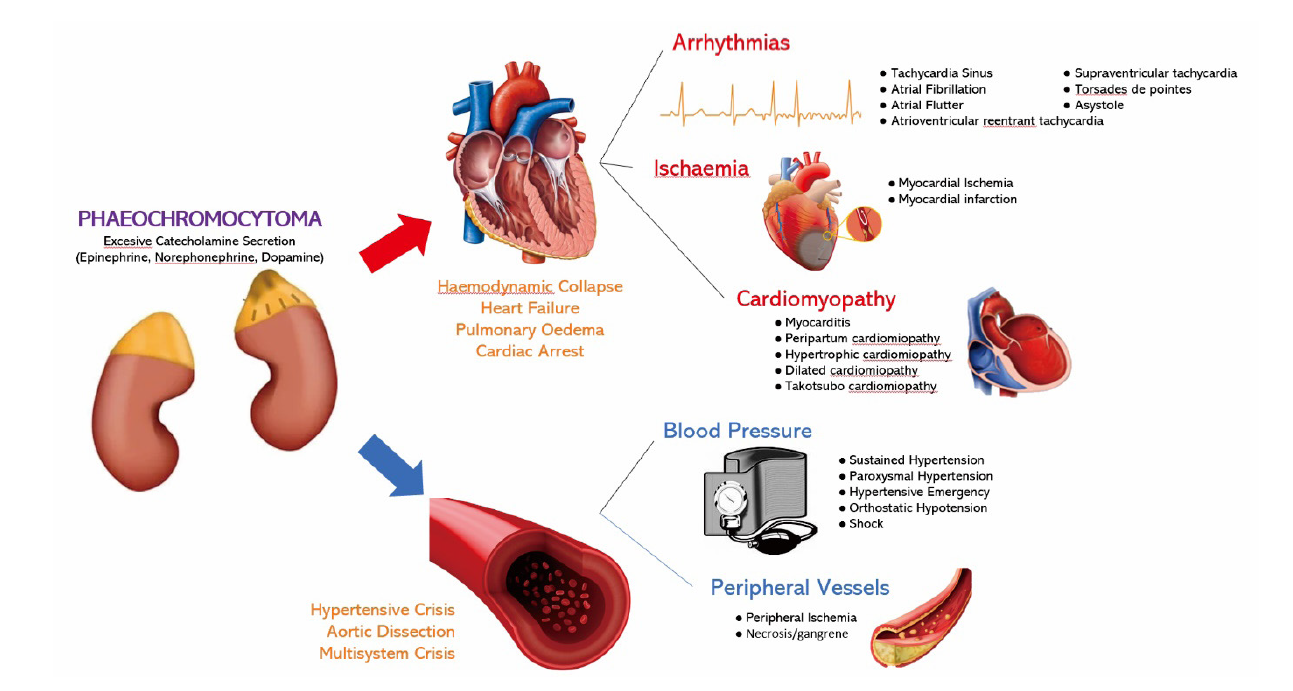Cardiovascular Presentation in Pheochromocytoma: What We Should be Aware
DOI:
https://doi.org/10.33192/smj.2022.9Keywords:
Pheochromocytoma, cardiovascular manifestations, endocrine heart diseaseAbstract
Pheochromocytoma is a catecholamine-producing tumor that although being a rare disease, it poses diagnostic problems because its clinical presentation often mimics certain diseases, including cardiovascular disorders. The effects of excessive catecholamine secretion cause a variety of cardiovascular presentations ranging from hypertension to life-threatening cases such as hypertensive emergency, shock, supraventricular or ventricular arrhythmias, pulmonary edema, and acute coronary syndromes. The principal medical treatment for pheochromocytoma is a blockade of adrenergic receptors. However, surgical or tumor resection often provides complete resolution of abnormal myocardial dysfunction or arrhythmias, so this approach remains the mainstay of treatment that should be performed as soon as the diagnosis of pheochromocytoma is established. As clinicians, we must be aware of the characteristics of the cardiovascular manifestations of pheochromocytoma to make an earlier diagnosis and more appropriate management.
References
Pourian M, Mostafazadeh D, Soltani A. Does this Patient Have Pheochromocytoma? A Systematic Review of Clinical Signs and Symptoms. Journal of Diabetes and Metabolic Disorders. 2016; 15 (11): 1-12.
Delekta J, Riadhi S, Eschen O. Rare cause of ventricular tachycardia: Pheochromocytoma. Journal of Cardiology Cases. 2015; 11(2): 62-5.
Vilcant V. Pheochromocytoma-induced Cardiomyopathy Mimicking Acute Coronary Syndrome. The Journal of The American Osteopathic Association. 2017; 17: 537-40.
Shawa H, Elsayes KM, Javadi S, Sircar K, Jimenez C, Habra MA. Clinical and radiologic features of pheochromocytoma/ganglioneuroma composite tumors: a case series with comparative analysis. Endocrine Practice. 2014; 20(9): 864-9.
Gimm O, Koch CA, Januszewicz A, Opocher G, Neumann HP. The genetic basis of pheochromocytoma. Frontiers of Hormone Research. 2004; 31: 45-60.
Fu SQ, Wang SY, Chen Q, Liu YT, Li ZL, Sun T. Laparoscopic versus open surgery for pheochromocytoma: a meta-analysis. BMC Surgery. 2020; 20(1): 167.
Prejbisz A, Lenders J, Eisenhofer G, Januszewicz A. Cardiovascular Manifestations of Pheochromocytoma. Journal of Hypertension. 2011; 29(11): 2049-60.
Garg MK, Kharb S, Brar KS, Gundgurthi A, Mittal R. Medical management of pheochromocytoma: Role of the endocrinologist. Indian Journal of Endocrinology Metabolism. 2011; 15 (Suppl4): S329-36.
Gu YW, Poste J, Kunal M, Schwarcz M, Weiss I. Cardiovascular Manifestations of Pheochromocytoma. Cardiology in Review. 2017; 25(5): 215-22.
Shawa H, Bajaj M, Cunningham G. Pheochromocytoma-induced Atrial Tachycardia Leading to Cardiogenic Shock and Cardiac Arrest. Texas Heart Institute Journal. 2014; 41(6): 660-3.
Hassan SY, Falhammar H. Cardiovascular Manifestations and Complications of Pheochromocytomas and Paragangliomas. Journal of Clinical Medicine. 2020; 9(2435): 1-19.
Zhang M, Mao W, Wu D, Liu P. Pheochromocytoma with Ventricular Tachycardia as The Presenting Symptoms. Chinese Medical Journal. 2016; 129(12): 1505-6.
Bernard M, Gold M, Cuoco F. Pheochromocytoma Presenting as Recurrent Stress Cardiomyopathy with Multiple Monomorphic Ventricular Tachycardias. The Journal of Innovations in Cardiac Rhythm Management. 2012; 3: 803-8.
Mederos MA, Orr LE, Livhits MJ, Rigberg DA. Management of acute limb ischemia related to underlying pheochromocytoma. Journal of Vascular Surgery Cases, Innovation and Techniques. 2020; 6(2): 272-6.
Leite L, Macedo P, Santos S, Quaglia L, Mesaz C, Paola A. Life-Threatening Cardiac Manifestations of Pheochromocytoma. Case Reports in Medicine. 2010; 1-4.
Yamada Y, Fujiwara H, Banno H, et al. Complete atrioventricular dissociation and sinus arrest after pheochromocytoma resection. IJU Case Report. 2020; 3(3): 108-11.
Choi SY, Cho KI, Han YJ, et al. Impact of Pheochromocytoma on Left Ventricular Hypertrophy and QTc Prolongation: Comparison with Takotsubo Cardiomyopathy. Korean Circ J. 2014; 44(2): 89-96.
Li S, Wang T, Wang L, et al. Ventricular Tachycardia and Resembling Acute Coronary Syndrome during Pheochromocytoma Crisis. Medicine. 2016; 95(14): 3297-301.
Paulin F, Klein G, Gula L, Skanes A, Yee R, Krahn A. QT Prolongation and Monomorphic VT Caused by Pheochromocytoma. Journal of Cardiovascular Electrophysiology. 2009; 20(8): 931-34.
Čtvrtlík F, Koranda P, Schovánek J, Škarda J, Hartmann I, Tüdös Z. Current diagnostic imaging of pheochromocytomas and implications for therapeutic strategy. Experimental and Therapeutic Medicine. 2018; 15(4): 3151-60.

Published
How to Cite
Issue
Section
License
Authors who publish with this journal agree to the following conditions:
Copyright Transfer
In submitting a manuscript, the authors acknowledge that the work will become the copyrighted property of Siriraj Medical Journal upon publication.
License
Articles are licensed under a Creative Commons Attribution-NonCommercial-NoDerivatives 4.0 International License (CC BY-NC-ND 4.0). This license allows for the sharing of the work for non-commercial purposes with proper attribution to the authors and the journal. However, it does not permit modifications or the creation of derivative works.
Sharing and Access
Authors are encouraged to share their article on their personal or institutional websites and through other non-commercial platforms. Doing so can increase readership and citations.














